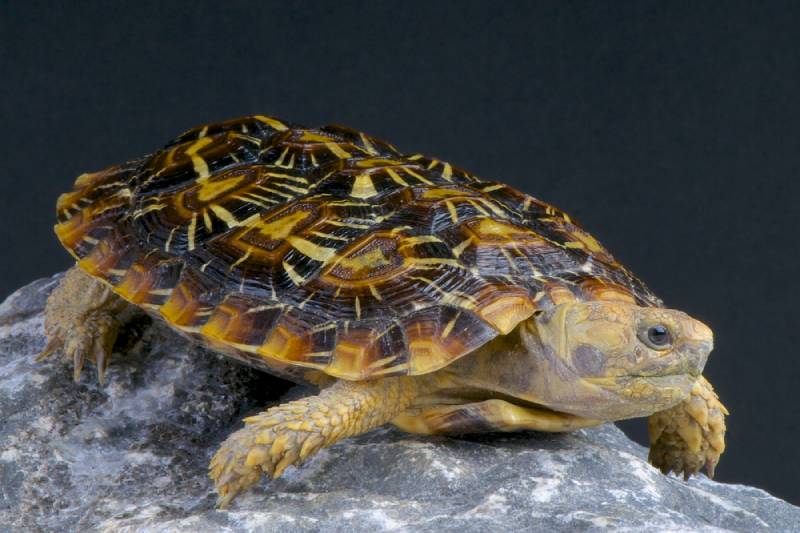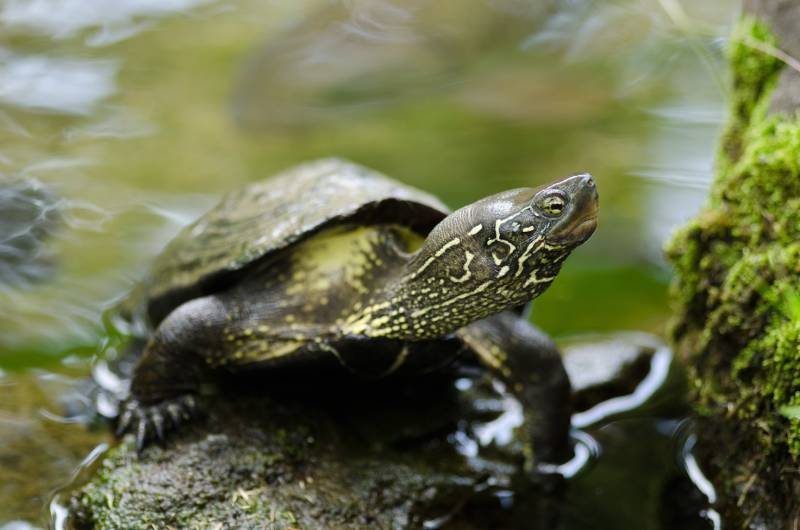How to Take Care of a Baby Turtle? 11 Essential Tips
Updated on
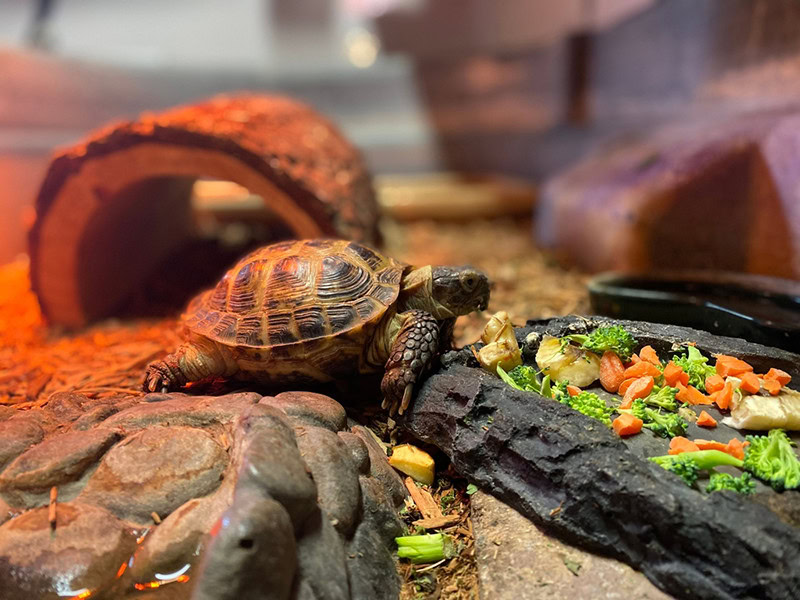
Turtles aren’t great pets for every family. While having a baby turtle or tortoise might sound awesome, these animals require special care, attention, and husbandry to thrive. Without the right environment, a poorly looked-after turtle can develop serious—even life-threatening—health conditions.
Read on to learn everything you need to know to ensure your baby turtle stays healthy and thriving.
Before You Get the Turtle: Things You’ll Need
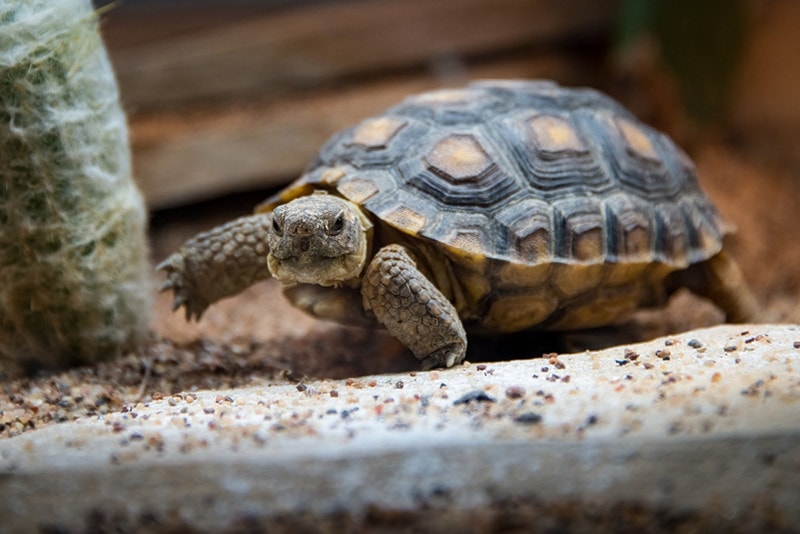
- Enclosure
- Lighting system
- Heating system
- Filtration system
- Substrate
- Basking Rock
- Digital probe thermometer
- Hygrometer
- Turtle pellets
- Calcium supplements
- Vegetables
- Live protein (only for some species)
The 11 Tips for Caring for Your Baby Turtle
1. Choose the Right Enclosure
Your enclosure will depend on your turtle’s species, as semi-aquatic and ground-dwelling turtles have different needs.
For example, box turtles, such as the Ornate Box Turtle, need a big enough enclosure to provide space to explore, forage, exhibit natural behaviors, or thermoregulate.
The semi-aquatic Painted Turtle needs housing that can accommodate at least 10 gallons of water per inch of its shell length. Some can grow to be 10 inches long, requiring a tank that can hold at least 100 gallons of water.
A Pancake Tortoise is a terrestrial (ground-dwelling) species. They’re natural climbers and need an enclosure with plenty of vertical space to fit rock stacks as they’d encounter in the wild.

2. Get a Lighting System
Most pet turtles are diurnal, meaning they’re the most active during the day. This also means they’ll require UVB exposure and bright light for physical and mental health. Therefore, you will need to invest in a high-quality lighting system to ensure your pet is getting all its needs met.
UVB lighting can be hard to get the strength right because you need to factor in the distance your turtle will be from the light source. Most experts agree the Zoo Med ReptiSun 5.0 T5 should provide adequate UVB, though you’ll also need to consider if your turtle’s enclosure has a mesh screen obstructing the UVB bulb’s penetration.
Unfortunately, UVB bulbs aren’t bright enough to simulate daylight, so you’ll need to supplement with a bright fluorescent or LED bulb spaning three-quarters of your turtle’s enclosure. This LED bar from Jungle Dawn is a great option.
Tip: Put the lights on a timer so you don’t need to remember to turn them on and off.
3. Get the Heating and Humidity Right
Turtles and tortoises are cold-blooded, meaning they need access to different temperatures to thermoregulate. For example, a wild turtle will move to a sunny spot to bask when it needs warming up. If your pet will be kept indoors, it will need an external heat source to meet its needs.
You’ll need to invest in at least one halogen flood heat lamp. You’ll need multiple lamps if you’re keeping more than one turtle or tortoise.
The temperature of your turtle’s basking and cool areas will depend on the species. A Pancake Tortoise needs a basking area between 100–108°F, while its cool zone should be 75–85°F. An Ornate Box Turtle has slightly cooler needs, with a basking area between 90–95°F and a cool zone of 70–77°F.
You’ll need to consider the water temperature for aquatic turtles. For a Painted Turtle, the water temperature should be between 78–80°F for juveniles and slightly cooler for adults, 70–76°F.
A digital probe thermometer is necessary to keep tabs on the temperature in your pet’s enclosure.
Humidity is another thing to keep in mind. Your turtle’s required humidity levels will depend on its species. Some fare better in environments with higher humidity levels and much moisture, while others thrive best in arid environments. A digital hygrometer is necessary to monitor the enclosure’s humidity.

4. Maintain the Water
Aside from ensuring your semi-aquatic turtle’s water is at the right temperature, you must also keep it clean. This requires a high-quality filtration system and regular water changes. This is one of the most expensive and time-consuming aspects of keeping aquatic turtles and is not an aspect of your pet’s husbandry to cheap out on.
Invest in a canister-style filter that can handle at least double the water in your enclosure. For example, if your aquarium holds 100 gallons of water, buy a filtration system with 200 gallons of filler power.
A filtration system isn’t enough, though. You should be removing and replacing around 30% of the tank’s water every one to two weeks.
5. Get the Right Substrate
The substrate serves many purposes in a turtle’s enclosure. Not only does it provide a natural-looking environment for your pet, but it also provides an area for colonization of beneficial bacteria. Without a healthy population of bacteria in an aquatic situation, the aquarium can turn cloudy, smelly, and unhealthy for your pet.
Generally speaking, the best substrate for turtles like box turtles and tortoises is a natural substance you’d find in their native habitat. However, this will vary by species. Zoo Med ReptiSoil is a good pick for many species but may not be appropriate for all.
Semi-aquatic turtles will also need land in their tanks to give them a spot to warm up and dry out. A basking platform is usually enough to achieve this.

6. Don’t Forget the Décor
Your turtle will need décor in its tank, not only to make it look good but to act as environmental enrichment. These items will provide opportunities for exercise and stimulate your pet’s instincts. We recommend choosing from the following:
- Hideouts
- Burrows
- Caves
- Dirt mounts
- Edible plants
- Flat stones
- Hollow logs
7. Appropriate Food
Your turtle’s diet will, again, depend on its species. Many pet turtles are omnivorous, meaning they eat plant and animal materials. The exception to this rule is tortoises, as they’re herbivores and only eat plant materials.
A baby turtle should be provided with as much food as it can eat daily. Once it reaches adulthood, however, you’ll need to reduce how much you’re feeding to prevent obesity.
Here are some ideas of what you can feed your turtle:
| Plant Matter | Animal Matter |
| Collard greens | Crickets |
| Dandelion greens | Earthworms |
| Endive | Dubia roaches |
| Green leaf lettuce | Freeze-dried shrimp |
| Kale | Frozen bloodworms |
| Red leaf lettuce | Hornworms |
| Romaine | Snails |
| Squash (raw) | Mollies |
| Carrot (raw) | Guppies |
| Cactus pads | Earthworms |
| Sweet potato | Crayfish |
| Mustard greens | Silkworks |
You can offer fruits occasionally as a treat. The most popular fruit amongst turtles include:
- Berries (blackberries, strawberries)
- Grapes
- Apples
- Bananas
- Melon
- Papaya
Turtle pellets should be offered to baby turtles every other day, but cut back to two to three times a week once they hit the one-year mark.
Terrestrial turtles should always have access to clean drinking water.
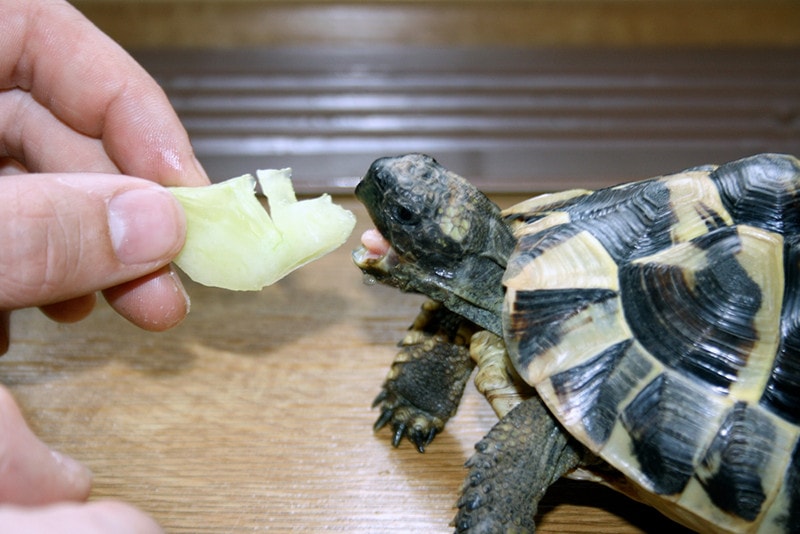
8. Appropriate Supplements
Calcium is a vital mineral that turtles need for their bones, shell, and muscular function. A cuttlebone is a great option for turtle species that prefer to eat in the water; otherwise, a powdered calcium supplement will do.
9. Visit an Exotic Vet
Within a few days of adopting your new baby turtle, take it to be examined by an exotic veterinarian. They should perform a thorough physical exam, including taking your pet’s weight, examining its mouth for signs of mouth rot, and looking for signs of malnutrition or dehydration. They may also run fecal tests to check for gastrointestinal parasites. Some exotic vets will deworm all new pet turtles for parasites.
Like all pets, you should take your turtle to the vet annually. Additionally, you may wish to request fecal testing for parasites at all your examinations.
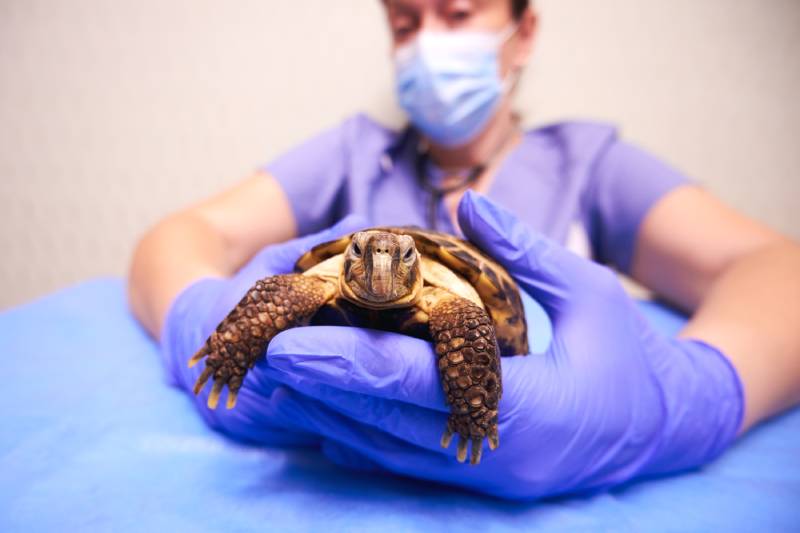
10. Reduce Handling
Your baby turtle will likely feel stressed when it arrives at your home. To reduce the stress on your pet, handle it as little as possible for the first few weeks. Ensure you wash your hands after handling your pet, as they carry germs like Salmonella.
Depending on your turtle’s species, it may get stressed when handled at all. This is a pet that’s often better to watch and look at than to touch.
If you must handle your turtle, pick it up from below with your palm instead of snatching from above. Hold onto its shell with both hands to support the body and legs.
11. Educate Yourself About Brumation
Some reptiles, including many turtle and tortoise species, experience a cycle of hibernation known as brumation. While your baby turtle shouldn’t brumate for its first few years, learning more about this natural process is important now that you own a turtle. This period of dormancy occurs during the cooler months of the year and is generally triggered by cooler nighttime temperatures and reduced daylight hours.
Some indoor turtles may never go through brumation, but it is generally considered necessary for overall health. It plays an important role in hormone regulation, and some studies even found that turtles prevented from bromating are more likely to fall ill and die sooner.
The more you know about brumation, the better equipped you’ll be to handle it when/if your turtle begins bromating. Your pet should spend its summer months preparing nutritionally, and a pre-and post-brumation exam by your vet should be in order.
Turtles or tortoises that are young, sick, or injured shouldn’t brumate. Discuss with your exotic vet to learn how to prevent this.
 Final Thoughts
Final Thoughts
Knowing how to care for your new baby turtle will ensure you give it the best shot at life. Now that you know the proper husbandry for your new pet, you can gather all the supplies you’ll need to give it the best life possible.
Featured Image Credit: Wirestock Creators,Shutterstock




